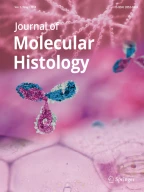906Accesses
33Citations
6 Altmetric
Synopsis
An investigation of the role of phosphotungstic and phosphomolybdic acids in Mallory-like trichrome methods showed unexpectedly that, rather than acting as mordants to anionic dyes, these polyacids selectively blocked staining of all tissue components other than connective tissue fibres to Aniline Blue and other similar fibrereactive dyes. Connective tissue components were found to contain residues resembling histidine that are easily accessible to anionic dyes. Blocking towards typical anionic dyes for demonstrating plasma proteins, such as Biebrich Scarlet, was also demonstrated but was less complete. The blockade of both types of dye was labile if the staining times were extended; plasma dyes were more sensitive than fibre dyes in this respect. Histochemical reactions for tyrosine residues were blocked. In connective tissue, phosphotungstic acid did not block histidine residues demonstrable by the coupled tetrazonium reaction with previous iodination. Thus it is postulated that differential trichrome staining occurs by binding of Aniline Blue to basic residues in the connective tissue not blocked by phosphotungstic acid and subsequent replacement of the blocking agent by an anionic dye. The binding of phosphotungstic acid to both epithelium and connective tissue was demonstrated by the quenching of autofluorescence in these regions and by the reduction of the bound PTA to blue coloured products with titanium trichloride.
This is a preview of subscription content,log in via an institution to check access.
Access this article
Subscribe and save
- Starting from 10 chapters or articles per month
- Access and download chapters and articles from more than 300k books and 2,500 journals
- Cancel anytime
Buy Now
Price includes VAT (Japan)
Instant access to the full article PDF.
Similar content being viewed by others
Explore related subjects
Discover the latest articles, books and news in related subjects, suggested using machine learning.References
Adams, C. W. M. (1957). Ap-dimethylaminobenzaldehyde-nitrite method for histochemical demonstration of tryptophan and related compounds.J. clin. Path.10, 56–62.
Baker, J. R. (1956). The histochemical recognition of phenols, especially tyrosine.Quart. Jl. microsc. Sci.97, 161–4.
Barrnett, R. J. &Seligman, A. M. (1954). Histochemical demonstration of sulphydryl and disulfide groups of protein.J. natn. Cancer Inst.14, 769–803.
Brain, E. B. (1962). A new method for preparation of decalcified sections of human enamelin situ.Archs. oral Biol.7, 757–60.
Bullmer, D. (1962). Observations on histological methods involving the use of phosphotungstic and phosphomolybdic acids, with particular reference to staining with phosphotungstic acid-hematoxylin.Quart. Jl. microsc. Sci.103, 311–23.
Everett, M. M., Miller, W. A. & Staple, P. H. (1971). Amino acid histochemistry of fetal calf and newborn human enamel matrix.Abstract No. 624.Annual meeting of International Association for Dental Research, Chicago.
Glick, D. &Scott, J. E. (1970). Phosphotungstic Acid not a stain for polysaccharide.J. Histochem. Cytochem.18, 455.
Goland, P., Scheiman-Tagger, E. &Engel, M. (1965). Enamel preservation during decalcification following fixation by some reactive halogen compounds.J. dent. res.44, 342–9.
Goland, P. P., Burlakow, P. S. &Grand, N. G. (1967). Cyanuric chloride for improved cytological fixation.Acta cytologica11, 267–71.
Lillie, R. G. (1965).Histopathologic Technique and Practical Histochemistry, p. 548. New York: McGraw-Hill.
Landing, B. H. &Hall, H. E. (1956). Selective demonstration of histidine.Stain Technol.31, 197–200.
Miller, W. A. &Everett, M. M. (1972). Amino acid histochemistry of developing and diseased dentine with comparisons to bone.Caries Res.6, 280 (Abstract).
Palladini, G., Lauro, G. &Basile, A. (1970). Observations sur la spécificité de la coloration aux acides phosphotungstique et phosphomolybdique.Histochemie24, 315–21.
Pearse, A. G. E. (1968).Histochemistry, Theoretical and Applied, Vol. I, Chapter 6. Boston: Little, Brown.
Pease, D. C. (1966). Polysaccharides associated with the exterior surface of epithelial cells: Kidney, intestine, brain.J. Ultrastruct. Res.15, 555–88.
Pease, D. C. (1970). Phosphotungstic acid as a specific electron stain for complex carbohydrates.J. Histochem. Cytochem.18, 455–8.
Puchtler, H. &Isler, H. (1958). The effect of phosphomolybdic acid on the stainability of connective tissue by various dyes.J. Histochem. Cytochem.6, 265–70.
Quintarelli, G., Zito, R. &Cifonelli, J. A. (1971a). On phosphotungstic acid staining. I.J. Histochem. Cytochem.19, 641–7.
Quintarelli, G., Cifonelli, J. A. &Zito, R. (1971b). On phosphotungstic acid staining. II.J. Histochem. Cytochem.19, 648–53.
Scott, J. E. (1971). Phosphotungstate: A ‘universal’ (non-specific) precipitant for polar polymers in acid solution.J. Histochem. Cytochem.19, 689–95.
Scott, J. E. &Glick, D. (1971). The invalidity of ‘phosphotungstic acid as a specific electron stain for complex carbohydrates’.J. Histochem. Cytochem.19, 63–4.
Terner, J. Y. (1964). Phosphotungstic acid-hematoxylin; spectrophotometry of the lake in solution and in stained tissue.Stain Technol.39, 141–53.
Author information
Authors and Affiliations
Department of Oral Biology, State University of New York at Buffalo, 14226, Snyder, New York, USA
Mona M. Everett & William A. Miller
- Mona M. Everett
Search author on:PubMed Google Scholar
- William A. Miller
Search author on:PubMed Google Scholar
Rights and permissions
About this article
Cite this article
Everett, M.M., Miller, W.A. The role of phosphotungstic and phosphomolybdic acids in connective tissue staining I. Histochemical studies.Histochem J6, 25–34 (1974). https://doi.org/10.1007/BF01011535
Received:
Revised:
Issue date:
Share this article
Anyone you share the following link with will be able to read this content:
Sorry, a shareable link is not currently available for this article.
Provided by the Springer Nature SharedIt content-sharing initiative


